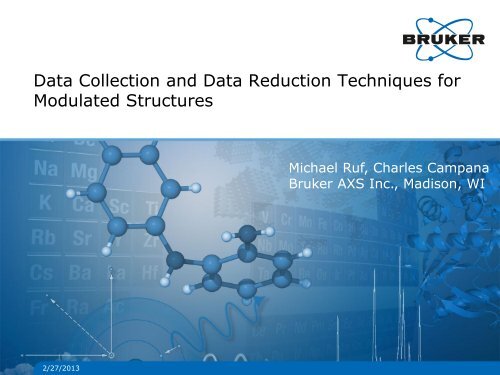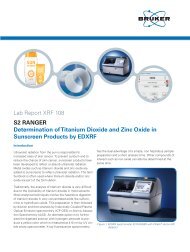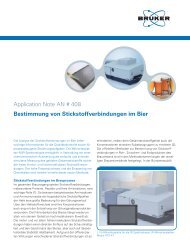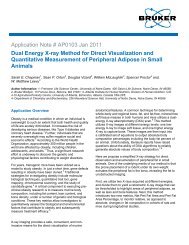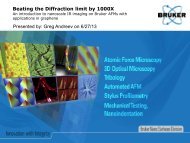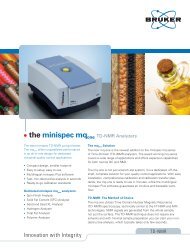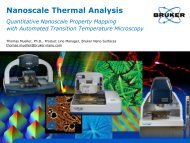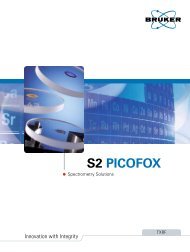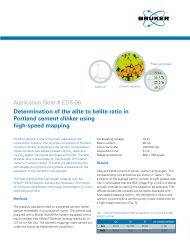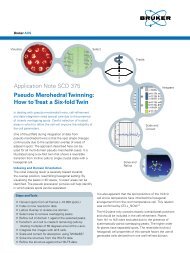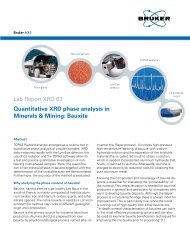Data Collection and Data Reduction Techniques for ... - Bruker
Data Collection and Data Reduction Techniques for ... - Bruker
Data Collection and Data Reduction Techniques for ... - Bruker
You also want an ePaper? Increase the reach of your titles
YUMPU automatically turns print PDFs into web optimized ePapers that Google loves.
<strong>Data</strong> <strong>Collection</strong> <strong>and</strong> <strong>Data</strong> <strong>Reduction</strong> <strong>Techniques</strong> <strong>for</strong><br />
Modulated Structures<br />
Michael Ruf, Charles Campana<br />
<strong>Bruker</strong> AXS Inc., Madison, WI<br />
2/27/2013
Dr. Michael Ruf – Product Manager – Single Crystal Diffraction<br />
2/27/2013 2
Dr. Charles Campana – Senior Applications Scientist<br />
2/27/2013 3
Outline<br />
• Pseudoephedrine Hydrochloride<br />
• Single crystal <strong>and</strong> powder data at varying temperatures<br />
• Chasing the transition temperature<br />
• Short introduction to commensurate/incommensurate structures<br />
• Processing higher dimensional data<br />
• Indexing<br />
• Q-vector determination<br />
• HKL <strong>for</strong>mat 6 data<br />
• Commensurate vs. incommensurate<br />
• An organic polycyclic compound<br />
• Commensurate modulation<br />
• Refinement results from Jana<br />
• Visualization<br />
2/27/2013<br />
4
Pseudoephedrine Hydrochloride<br />
in the literature<br />
2/27/2013<br />
5
Is this the whole story?<br />
• What are these additional<br />
spots?<br />
• No mentioning of additional<br />
reflections or satellites on<br />
Precession photographs<br />
• <strong>Data</strong> were collected at room<br />
temperature<br />
2/27/2013<br />
6
Pseudoephedrine at Low Temperature<br />
<strong>and</strong> at Room Temperature<br />
• Problematic thermal ellipsoids at low temperature<br />
R1 = 2.22% R1 = 2.82%<br />
2/27/2013<br />
7
Single crystal experiments<br />
• <strong>Data</strong> collection temperatures:<br />
53 °C, 23 °C, -73 °C, -123 °C, -173 °C <strong>and</strong> -193 °C<br />
• Instrumentation:<br />
APEX DUO, Mo-radiation<br />
Cryostream 700+<br />
• <strong>Data</strong> collection strategy:<br />
omega <strong>and</strong> phi scans,<br />
0.3°, 10s<br />
• Software:<br />
APEX2<br />
2/27/2013<br />
8
Diffraction pattern at varying<br />
temperatures<br />
• Diffraction patterns show<br />
two trends at lower<br />
temperatures<br />
• Diffraction to higher<br />
2Theta angles<br />
• More (satellite)<br />
reflections<br />
2/27/2013<br />
9
h0k layer – pseudo-precession frames<br />
• Pseudo precession<br />
images reconstructed<br />
from complete data sets<br />
• More satellites at lower<br />
temperature<br />
• Almost no satellites<br />
detectable at high<br />
temperature<br />
• Satellites are rather<br />
weak<br />
• So where do all these<br />
additional spots come<br />
from?<br />
2/27/2013<br />
10
A closer look at how the satellites change<br />
with temperature<br />
1 0 8<br />
2/27/2013<br />
11
Ratio of intensity of main reflection to<br />
satellites<br />
• The relative<br />
intensity of the<br />
satellite reflections<br />
is the highest <strong>for</strong><br />
the data collected at<br />
-123° C<br />
• Satellites become<br />
relatively weaker at<br />
lower temperatures<br />
• What would happen<br />
at -270 ° C<br />
53° C -123° C -193° C<br />
2/27/2013<br />
12
How to better describe the structure?<br />
• Take the satellites into<br />
account <strong>and</strong> quadruple<br />
the a-axis<br />
• Symmetry is now<br />
decreased from<br />
orthorhombic to<br />
monoclinic<br />
• Spacegroup changes<br />
from P2 1 2 1 2 1 to P2 1<br />
• Twinning is introduced<br />
as a 180° rotation<br />
about the c-axis<br />
• Structure refines to<br />
R1=2.48%<br />
• Modulation becomes<br />
quite obvious<br />
2/27/2013<br />
13
How to even better describe the structure?<br />
• Determine the<br />
q-vector<br />
• Integrate main<br />
reflections with<br />
satellites using a<br />
q-vector concept<br />
• Produce hkl 6 <strong>for</strong>mat<br />
files <strong>for</strong> data<br />
processing in Jana<br />
2006<br />
• Refine the structure<br />
as a modulated<br />
structure<br />
2/27/2013<br />
14
Two-dimensional periodic arrangement<br />
2/27/2013<br />
15
Diffraction pattern of a two-dimensional<br />
periodic arrangement<br />
2/27/2013<br />
16
Two-dimensional periodic arrangement<br />
perturbed by a modulation<br />
2/27/2013<br />
17
Diffraction pattern of a two-dimensional<br />
modulated arrangement<br />
2/27/2013<br />
18
Defining the modulation vector q<br />
- 2q - q q 2q<br />
2/27/2013<br />
19
The q-vector concept<br />
These spots are regularly distributed <strong>and</strong> they can be indexed if one or<br />
more additional vectors are added to the reciprocal basis. The general<br />
diffraction spot at Q can be expressed as<br />
where the vector q is called the modulation vector. Reflections having<br />
index m equal to zero are the main reflections, the others are satellite<br />
reflections. The modulation vector q can be expressed in the reciprocal<br />
basis:<br />
q a<br />
* * *<br />
1 a<br />
2 a<br />
3<br />
2/27/2013 20
Types of Modulated Structures<br />
Commensurate cases<br />
If the superspots are located at simple fractions of the vectors of<br />
the reciprocal lattice of the substructure, e.g., at q=(½,0,0), the<br />
resulting broken symmetry is a doubling of the unit cell along the a<br />
axis. Such a modulation is called a commensurate superstructure.<br />
Incommensurate cases<br />
In some materials, superspots will occur at positions that do not<br />
represent a simple fraction, say q=(0.5234,0,0). In such a case a<br />
structure results that strictly speaking has lost all translational<br />
symmetry in a particular direction. This is called an<br />
incommensurate structure.<br />
2/27/2013 21
Supercells<br />
In the commensurate case, we can use a regular<br />
three-dimensional description as the basic vectors<br />
can be trans<strong>for</strong>med into a proper supercell.<br />
However, such an approach may not be convenient<br />
as satellites are often very weaker <strong>and</strong> the number<br />
of observable reflections may not be sufficient to<br />
solve <strong>and</strong> refine the structure in a supercell.<br />
2/27/2013 22
Identifying the main lattice (1)<br />
• Harvested<br />
reflections from<br />
300 frames using<br />
APEX2 software –<br />
about 4000<br />
reflection<br />
• Display reflections<br />
in RLATT<br />
• Identify main<br />
lattice<br />
• Select main lattice<br />
reflections<br />
2/27/2013<br />
23
Identifying the main lattice (2)<br />
• Harvested<br />
reflections from<br />
300 frames using<br />
APEX2 software –<br />
about 4000<br />
reflection<br />
• Display reflections<br />
in RLATT<br />
• Identify main<br />
lattice<br />
• Select main lattice<br />
reflections<br />
2/27/2013<br />
24
Identifying the main lattice (3)<br />
• Harvested<br />
reflections from<br />
300 frames using<br />
APEX2 software –<br />
about 4000<br />
reflection<br />
• Display reflections<br />
in RLATT<br />
• Identify main<br />
lattice<br />
• Select main lattice<br />
reflections<br />
2/27/2013<br />
25
Identifying the main lattice (4)<br />
• Harvested<br />
reflections from<br />
300 frames using<br />
APEX2 software –<br />
about 4000<br />
reflection<br />
• Display reflections<br />
in RLATT<br />
• Identify main<br />
lattice<br />
• Select main lattice<br />
reflections<br />
2/27/2013<br />
26
Indexing the main lattice<br />
• Defined about<br />
2,600 reflections<br />
belonging to the<br />
main lattice –<br />
gray group<br />
• Indexing on the<br />
gray group only<br />
• Refinement <strong>and</strong><br />
Bravais proposes<br />
an orthorhombic<br />
cell<br />
2/27/2013<br />
27
Defining the satellites – q vector (1)<br />
• Reflection array<br />
aligned along a*<br />
• Switch to<br />
“incommensurate<br />
mode”<br />
2/27/2013<br />
28
Defining the satellites – q vector (2)<br />
• Folding the main lattice on itself<br />
• Removing three dimensions<br />
2/27/2013<br />
29
Defining the satellites – q vector (3)<br />
• Folding the main lattice on itself<br />
• Removing three dimensions<br />
• Setting the q-vector<br />
2/27/2013<br />
30
<strong>Data</strong> integration<br />
• The q–vector is written to<br />
APEX2’s database <strong>and</strong> part of<br />
the p4p file<br />
• SAINT automatically switches<br />
to “incommensurate mode”<br />
<strong>and</strong> generates a hklf 6 type<br />
output file with a .ram<br />
extension<br />
• Specify the Maximum Satellite<br />
Index in the integration<br />
options dialog<br />
• SAINT refines the q-vector<br />
during data integration<br />
• The q-vector refined to about<br />
0.238 <strong>for</strong> all pseudoephedrine<br />
data sets<br />
2/27/2013<br />
31
<strong>Data</strong> scaling<br />
• SADABS was modified to h<strong>and</strong>le the .ram files created by SAINT<br />
• SADABS will create a hk6 file which can be used with Jana 2006<br />
2/27/2013<br />
32
Structure refinement in Jana 2006<br />
• <strong>Data</strong> were used <strong>for</strong> teaching purposes during the ACA Jana<br />
workshop<br />
• The structure was refined in the super-spacegroup<br />
P212121(00g)000<br />
• Several different models gave similar R-values which supports<br />
the fact that the modulation is not very strong<br />
• Modulated structure approach<br />
• Commensurate (supercell)<br />
• Incommensurate with overlap (of satellite reflections) option<br />
2/27/2013<br />
33
Step-wise procedure <strong>for</strong> collecting <strong>and</strong><br />
processing modulated structure data<br />
• Collect hemisphere of high quality data<br />
• Harvest large number of reflections with low I/sigma threshold<br />
(e.g., 1.75).<br />
• Determine basic unit cell with very large I/sigma (e.g., 250)<br />
threshold.<br />
• Use Incommensurate tool in RLATT to determine q-vector <strong>and</strong><br />
number of satellite peaks.<br />
• Integrate data to produce *.ram files.<br />
• Scale the data to carry out absorption corrections on main<br />
reflections as well as satellites.<br />
• Prepare JANA2006-compatible .hk6 file<br />
• Input the corresponding .p4p <strong>and</strong> .hk6 files into JANA2006 to carry<br />
out solution <strong>and</strong> refinement of modulated structure.<br />
2/27/2013<br />
34
<strong>Collection</strong> of Modulated Structure <strong>Data</strong><br />
<strong>Data</strong> <strong>Collection</strong><br />
• <strong>Data</strong> were collected at room temperature on a <strong>Bruker</strong> Kappa<br />
APEX II system equipped with a Mo fine-focus x-ray tube<br />
operated at 1,500 watts (50 kV, 30 mA).<br />
• A total of 4,355 images were collected in 1024 x 1024 mode as<br />
phi or omega scans with 30-second exposure time at a detector<br />
distance of 60 mm. Total data collection time was 42 hours.<br />
2/27/2013<br />
35
<strong>Collection</strong> of Modulated Structure <strong>Data</strong><br />
2/27/2013<br />
36
Harvest Reflections<br />
• Reflections were harvested from the entire dataset with a very low<br />
threshold (e.g., 1.75)<br />
2/27/2013<br />
37
Determination of the sub-cell –<br />
initial unit cell<br />
• After harvesting, the threshold parameter was set to a very high<br />
value (e.g., 250) <strong>for</strong> indexing.<br />
• The difference vector method produced a small triclinic cell with a<br />
high score.<br />
2/27/2013<br />
38
Refinement of the initial unit cell<br />
2/27/2013<br />
39
Determination of the Bravais lattice<br />
I-centered orthorhombic<br />
2/27/2013<br />
40
Refinement of the I-centered<br />
orthorhombic unit cell<br />
2/27/2013<br />
41
RLATT view of the I-centered unit cell<br />
2/27/2013<br />
42
RLATT view of the I-centered unit cell<br />
2/27/2013<br />
43
Use of RLATT to determine q-vector <strong>for</strong> the<br />
I-centered unit cell<br />
2/27/2013<br />
44
Integration of data with one q-vector,<br />
twinning <strong>and</strong> 4 orders of satellites<br />
2/27/2013<br />
45
Creation of JANA2006-compatible .hk6 file<br />
2/27/2013<br />
46
Format of JANA2006-compatible .hk6 file<br />
2/27/2013<br />
47
What’s wrong with it?<br />
strange geometry<br />
R 1 = 22.23%; res. el. density = 2.72 e - / Å 3<br />
Marilyn Olmstead<br />
2/27/2013<br />
48
Pseudo precession image - h1l<br />
2/27/2013<br />
49
Defining the satellites – q vector<br />
• Folding the<br />
main lattice on<br />
itself<br />
• Removing<br />
three<br />
dimensions<br />
2/27/2013<br />
50
Defining the satellites – q vector<br />
• Orientation along b*<br />
• Measuring tool<br />
• q vector 0.293 0.000 0.000<br />
2/27/2013<br />
51
Defining the satellites – q vector<br />
• Extended display <strong>for</strong> easier definition of satellite reflections<br />
• Order of three was chosen to split the measuring tool into<br />
three segments<br />
2/27/2013<br />
52
Defining the satellites – q vector<br />
• Color coding the satellite reflections<br />
2/27/2013<br />
53
Defining the satellites – q vector<br />
• Unfolding the<br />
reflection array<br />
2/27/2013<br />
54
Structure refinement<br />
The structure was refined in the super space group: P212121(a00)s00<br />
R factors : [16820=9856+6964/1609], Damping factor: 1.0000<br />
GOF(obs)= 1.61 GOF(all)= 1.30<br />
R(obs)= 5.00 Rw(obs)= 5.79 R(all)= 8.90 Rw(all)= 6.30<br />
R factors <strong>for</strong> main reflections : [3386=2579+807]<br />
R(obs)= 3.48 Rw(obs)= 3.99 R(all)= 5.23 Rw(all)= 4.24<br />
R factors <strong>for</strong> satellites of order 1 : [6704=4202+2502]<br />
R(obs)= 4.97 Rw(obs)= 6.20 R(all)= 8.07 Rw(all)= 6.59<br />
R factors <strong>for</strong> satellites of order 2 : [6730=3075+3655]<br />
R(obs)= 7.21 Rw(obs)= 7.66 R(all)= 13.70 Rw(all)= 8.73<br />
Maximal density : 0.45, minimal density : -0.32.<br />
Trixie Wagner <strong>and</strong> Andreas Schönleber<br />
2/27/2013<br />
55
Animated con<strong>for</strong>mation changes<br />
• Change of the molecular<br />
con<strong>for</strong>mation as<br />
function of the phase of<br />
the modulation t,<br />
viewed along c<br />
• The sequence along t<br />
was calculated in steps<br />
of 0.1.<br />
Trixie Wagner <strong>and</strong> Andreas Schönleber<br />
2/27/2013<br />
56
Animated con<strong>for</strong>mation changes<br />
• Change of the molecular<br />
con<strong>for</strong>mation as<br />
function of the phase of<br />
the modulation t,<br />
viewed along a<br />
• The sequence along t<br />
was calculated in steps<br />
of 0.1.<br />
Trixie Wagner <strong>and</strong> Andreas Schönleber<br />
2/27/2013<br />
57
Conclusion<br />
• Powerful tools to identify incommensurate data are available<br />
• <strong>Data</strong> collection at varying temperatures has been automated<br />
• Indexing <strong>and</strong> q-vector determination has been greatly improved<br />
• <strong>Data</strong> integration <strong>and</strong> scaling produces hkl 6 <strong>for</strong>mat data<br />
compatible with JANA 2006<br />
2/27/2013<br />
58
Jana2006 Tutorial<br />
2/27/2013<br />
59
© Copyright <strong>Bruker</strong> Corporation. All rights reserved.<br />
Innovation with Integrity
Importing of <strong>Bruker</strong> data into Jana2006<br />
• Create new structure within JANA2006<br />
2/27/2013 62
Importing of <strong>Bruker</strong> data into Jana2006<br />
• Browse to find .p4p file <strong>for</strong> project<br />
2/27/2013 63
Importing of <strong>Bruker</strong> data into Jana2006<br />
• Specify data source<br />
2/27/2013 64
Importing of <strong>Bruker</strong> data into Jana2006<br />
• Import data from .p4p file<br />
2/27/2013 65
Importing of <strong>Bruker</strong> data into Jana2006<br />
• Import data from .p4p <strong>and</strong> hk6 files<br />
2/27/2013 66
Importing of <strong>Bruker</strong> data into Jana2006<br />
• Determine Bravais Lattice<br />
2/27/2013 67
Importing of <strong>Bruker</strong> data into Jana2006<br />
• Determine Space Group <strong>and</strong> Superspace Group<br />
2/27/2013 68


